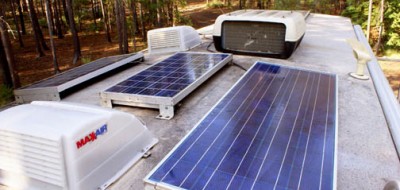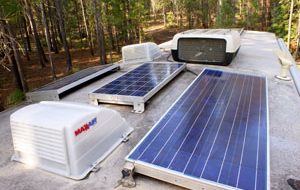By Bob Difley
 Most snowbirds have fled their winter desert hangouts and have moved or are moving north to their stick house or, if fulltiming, into their favorite summer destinations. Most will travel between favored campgrounds, but some will be heading into the national forests to boondock at their secret campsites, providing they haven’t been eliminated by the Forest Service’s new Travel Management Plan (TMR).
Most snowbirds have fled their winter desert hangouts and have moved or are moving north to their stick house or, if fulltiming, into their favorite summer destinations. Most will travel between favored campgrounds, but some will be heading into the national forests to boondock at their secret campsites, providing they haven’t been eliminated by the Forest Service’s new Travel Management Plan (TMR).
That’s another story, but briefly, new rules for driving and boondocking in the national forests now define where you can drive and where you can camp. Make sure you pick up the particular forest’s Motor Vehicle Use Map (MVUM) that defines the approved roads and dispersed camping areas.
However, another challenge awaits boondockers as well. That is producing enough electrical power from solar panels to meet your daily needs. In the desert, your considerations were:
- Because most desert campsites are open to the sky, you get charging from your panels from the first glint of sun over the morning horizon until it has passed out of view in the western sky.
- However, since the angle of the sun is lower, you will not get full charging unless you tilt your panels toward the sun’s trajectory across the sky, and position your RV horizontal to the sun’s movement, and verify that your panels–or other roof top equipment–do not shade the charging (silicon) part of the panel.
- Since the days are shorter, your total charging time will be shorter, and your batteries may not have sufficient time to become fully re-charged. Therefore, you may have to schedule more electricity-using hours (meals, showering, computer use) during daylight, so as not to deplete too much from your batteries overnight.
- When you move from the desert to a Ponderosa pine forested campsite, your challenges change.
The good news is that since the sun during the summer months passes more directly overhead, your panels do not have to be elevated to take full advantage of the suns’ rays throughout the day. Also, days are longer so you have many more charging hours every day than in the desert in winter, and since the number of nightime dark hours roughly equals the eight hours of sleep needed, most electricity-using can be accomplished while the panels are charging if you coordinate your sleeping and rising times with the sun’s.
But now comes the hard part. Since you are camping in a forest, you will undoubtedly have periods of the day when the sun is blocked from reaching your panels by the magnificent (and tall) trees surrounding your campsite. Short of camping out in the middle of a meadow (which can be nice but not always available) you will have to hazard a guess at how many daylight hours the sun is actually reaching your panels–without any part being shaded, which reduces the amount of amps that pass into your batteries–and calculate accordingly so you don’t find yourself with batteries that have not re-charged.
The remaining consideration in both desert and forest is the number of overcast or rainy days which will produce minimal battery charging. It is therefore a good idea to oversize your system to account for all the variables and calculate to include a margin of error. Checd your battery voltage daily to make sure you are balancing the discharging with charging.
For more RVing tips take a look at my Healthy RV Lifestyle website, where you will also find my ebooks: BOONDOCKING: Finding the Perfect Campsite on America’s Public Lands (PDF or Kindle), 111 Ways to Get the Biggest Bang for your RV Lifestyle Buck (PDF or Kindle), and Snowbird Guide to Boondocking in the Southwestern Deserts (PDF or Kindle).


Pingback: Travelgenio avis consommateur
Bill Weston
I like the idea of the solar power idea. Only problem I see is I like to camp where the trees are really dense which could cause a issue.
Pingback: The Unemployed Mom
solar energy system, best solar phone charger, solar powered home, continuous solar flares, solar lighting
Today, I went to the beachfront with my kids. I found a sea shell
and gave it to my 4 year old daughter and said “You can hear the ocean if you put this to your ear.” She placed the shell to her ear
and screamed. There was a hermit crab inside and
it pinched her ear. She never wants to go back! LoL I know this is
totally off topic but I had to tell someone!
Mark Reimers
I’ve worked in the solar industry for many years so here’s some additional information that might help.
As one poster mentioned, in the Summer months the path of the Sun is almost right over the top of us so having the panels lay flat on the roof of your RV is just fine. There are tilting mounting systems available for RV’s and those will be particularly helpful if you tend to be a year round traveler. Of course, you always have to mindful of which way you’re parking your RV so you can get the panels tilted the right way (South).
You now have two options when it comes to inverters (the component that converts AC current to DC). Traditional “string inverters” have been around for decades are very reliable. Panels are wired together in strings. Even with bypass diodes on each module, shade can still be very problematic. If you’ve been around as long as I have, you remember the old Christmas tree lights. If one bulb went out, the entire string went out. Well, it’s almost as bad with solar panels on a string inverter (but not quite) when there is shade. Shade a single module and you pretty much shut down the string.
The newer alternative are micro-inverters. Rather than having a single inverter for all the panels, you have one micro-inverter mounted behind each panel. The current is being converted from DC to AC right on the roof of your RV. The big thing here is that if one panel is being shaded it does not effect the output of the other modules. The operate completely independently. But there are two potential downsides to micro inverters. First, they are 10% to 25% more costly than string inverters. Secondly, because the micro inverter is mounted behind the module, those critical semi conductor components are being exposed to extreme environmental conditions.
Perhaps the best and most cost effective technology today comes from a company called Solar Edge. They offer a hybrid that combines the best of both options. They do have a box that is mounted behind the module, but it does not perform the tack of converting the current. Instead, the box performs the task that is referred to as Maximum Power Point Tracking. I’ll spare you the technical discussion, but it serves to get the optimum performance out of a module no matter what the conditions. The actual conversion of the DC current to AC is done by an inverter that is similar to a string inverter. However, the inverter is much simpler than a regular string inverter because it doesn’t have to do any Power Point Tracking. Hence, it’s cheaper. The bottom line is the Solar Edge inverter system is as cheap as string inverters with all of the benefits of micro inverters without the downside. And no, I am not associated with Solar Edge in any way.
A final word of caution. I have seen solar kit prices and module prices through RV distributors that are utterly outrageous. Do some shopping and contact me if you need some help.
Cheers
used rvs for sale
Solar panels are very helpful for making the vehicle life more longer as solar energy is the most efficient energy and very capable for storing energy.
Jimmy Mac
Just saw this on eBay, it looks sweet for a similar application but you can wheel it around with you!
http://www.ebay.com/itm/280871158053?ssPageName=STRK:MESELX:IT&_trksid=p3984.m1555.l2649
Wonder what the roof top setup costs?!
Cheers
John
Good points from Tom. I had wondered if there was a way around the woods/shade situation when you want to use solar panels. I am just about always parking in wooded lots.
Nelsee
we can go there our own RV?
butterbean carpenter
Howdy Boondocker Bob,
Really a good article on solar.. Thanks!!!
Tom Gourley
If you really want to be in the shade like me yet get a full charge then instead of roof mount i went with portable solar panels. I have 240 watts of panels charging 640amps of batteries and have spent weeks in the woods and never had a power issue. We do not do campgrounds, only boondocking and our only challenge is water. I purchased these panels from CEA Solar out of AZ. They were the best purchase i have made and i no longer carry the portable generator.
Geoffrey Pruett
The most practical way to handle shaded conditions is multiple panels. Properly installed, with a bypass diode at each panel, each will contribute the energy collected and if below charge level voltage will simply take up roof space. The spec sheet also will list the angles at which output drops off. This is listed in the install sheet for USA made panels, sometimes on others. This angle is part of the installation for fixed installs and requires some thought as the panel with the highest output at noon may be way off until the 10 to 2 sun angles. Picking solar panels is much like picking tires, if you pick with care you will forget they are there except for cleaning the glass from time to time. Do not try aiming panels on a RV roof, hospital time is expensive.
Elaine Cundiff
We are full timers that head for Mexico in the winter and the Rockies, Alaska or Newfoundland in the summer. Now we have no problem with meeting our electric needs with our solar panels. Our son, a solar engineer, said just stick up another solar panel as they are cheap. We have a total of 750 watts of panels on the roof with panels at each end and each side of the fiver so that we will get some solar power even if the trees cover part of the trailer. He did not want us getting on the roof changing the angle of the panels. “Too dangerous for us older folks” he said.
Enjoy boon docking, Elaine
Ron Lane
You speak of snowbirds and fulltimers… but you failed to mention us sunbirds. Where snowbirds escape the north and its cold during the winter by heading south, we sunbirds do the opposite. We escape the south and its heat during the summer by heading north. Snowbirds indicate a person is basically from the north…Sunbirds are those who basically are from the south. We spend our winters here in the mild Southern California desert, but head to the cool Oregon coast during the summer. Our solar panels on our MH are pretty much useless in the summer as the coast has morning fog and not unusual to have mild rains occasionally. However down here in Sou Cal during the summer time…our stick house panels work overtime! Boy, do they ever. We haven’t paid a electric bill since we installed them two years ago.